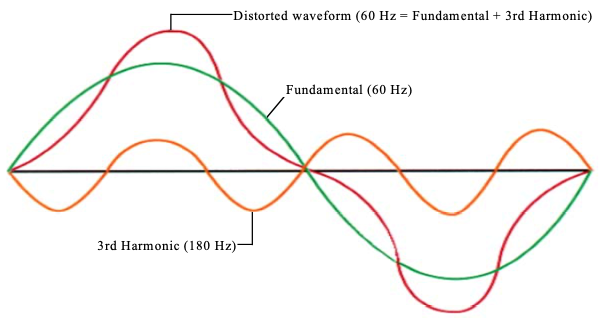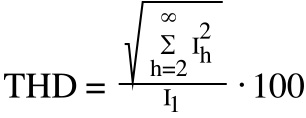Harmonics are voltages or currents caused by non-linear loads on a power supply. Harmonic frequencies occur at integer multiples of a fundamental frequency and are superimposed on the fundamental voltage or current waveform, creating a distorted waveform. Harmonics are classified first by their order, or the integer multiple of the fundamental frequency. For example, for a fundamental frequency of 60 Hz, the 3rd order harmonic would be 180 Hz, the 4th order harmonic would be 240 Hz, and so forth.

Image credit: Pacific Gas and Electric Company
Also referred to as the 1st harmonic, the fundamental frequency is the waveform that has the supply frequency (60 Hz in North America and parts of South America, and 50 Hz in most of the rest of the world).
Linear vs. non-linear loads
Loads on a power supply can be linear or non-linear, referring to the way in which the load draws current. Linear loads draw current that is proportional to voltage, resulting a sinusoidal relationship between the current and voltage waveforms. Non-linear loads, on the other hand, draw current only as needed, creating a distorted current waveform that contains harmonics. This, in turn, distorts the waveform of the supply voltage, causing voltage harmonics.
In addition to the order, or multiple of the fundamental frequency, harmonics are also classified by their sequence, which refers to the rotation of the harmonic with respect to the fundamental waveform. Positive sequence harmonics are the 4th, 7th, 10th, and so forth, and rotate in the same direction as the fundamental frequency. Negative sequence harmonics include the 2nd, 5th, 8th, and so forth. These harmonics rotate in a direction opposite the fundamental frequency.
Because they rotate in opposition to the fundamental frequency, negative sequence harmonics impede a motor’s function by weakening the motor’s rotating magnetic field, which reduces the amount of torque that can be produced. And although positive sequence harmonics rotate in the same direction as the fundamental frequency, they can cause excessive heating, which is damaging to motors, cables, and other equipment.
Notice that neither the positive nor the negative sequence harmonics include multiples of three. The odd integer multiples of the 3rd harmonic — 3rd, 9th, 15th, and so forth — are referred to as triplens and have no rotation. Triplens circulate between phase and neutral or ground, adding up in the common neutral wire. This can lead to the current in the neutral wire having an amplitude three times the amplitude of the phase current at the fundamental frequency, causing the neutral wire to overheat.
Power systems don’t typically contain even harmonics (2, 4, 6, 8, and so forth), and three-phase systems don’t contain triplens, or harmonics in odd integer multiples of three (3, 9, 15, 21, and so forth). So in the absence of even or triplen harmonics, motion control systems primarily experience 5th, 7th, 11th, and 13th order harmonics.
Total Harmonic Distortion
Total harmonic distortion (THD) is the degree to which the voltage or current waveform deviates from its pure sinusoidal shape due to the combination of all the harmonic elements. Mathematically, total harmonic distortion is the ratio of the root mean square (RMS) of the harmonic frequencies (from the 2nd harmonic to the nth harmonic) to the root mean square of the fundamental (first) frequency.

THD = total harmonic distortion (%)
h = harmonic order
In = nth order current or voltage harmonic*
I1 = first order current or voltage harmonic (fundamental frequency)
*THD for motor drives and other industrial systems is typically calculated for harmonics up to the 40th or 50th order.
Current and voltage harmonics can be detrimental to the loads being served and to the power supply system — particularly transformers. For motors driven by VFDs or servo amplifiers, the higher frequencies of the current harmonics cause increased core losses (which are frequency-dependent) in the motor. And current harmonics use capacity from the power supply without delivering real power to the connected loads, thus reducing the facility’s power factor. (Recall that power is only delivered to the load by the fundamental frequency current.)
Voltage harmonics are particularly detrimental to sensitive electronic equipment, and voltage harmonics with a negative sequence (5th and 11th order voltage harmonics, for example) reduce the amount of torque the motor can produce.
Fortunately, there are ways to reduce harmonic distortion and minimize its effects on the power system and connect loads. For VFDs that use a standard, diode-based rectifier, adding impedance via a line reactor or DC bus choke will reduce THD. Another option is to use an active front end (AFE) drive, which uses IGBTs, rather than diodes, to rectify the incoming AC power to DC. And VFDs that use 12-, 18-, or 24-pulse rectifiers can significantly reduce or even eliminate certain harmonics and lower THD.





Leave a Reply
You must be logged in to post a comment.